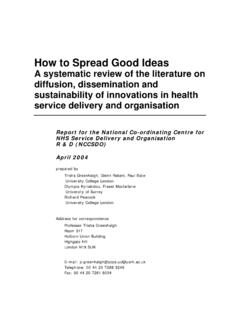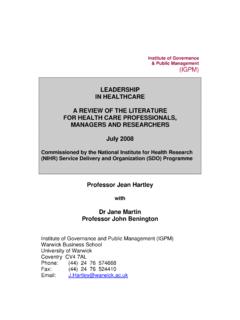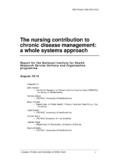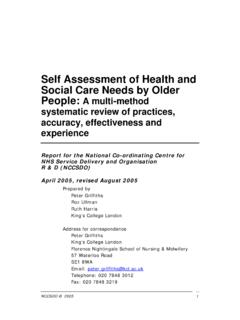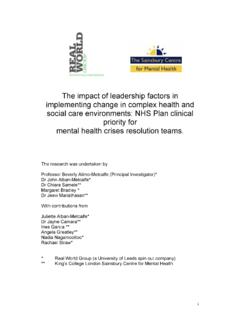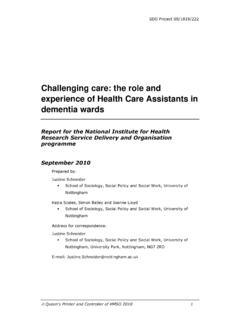Transcription of Developing Change Management Skills - netscc.ac.uk
1 ManagingChangein the NHSV alerie Iles and Steve CranfieldDeveloping ChangeManagement SkillsA RESOURCE FOR HEALTH CARE PROFESSIONALS AND MANAGERSD eveloping ChangeManagement SkillsA RESOURCE FOR HEALTH CARE PROFESSIONALS AND MANAGERSM anagingChangein the NHSV alerie Iles and Steve CranfieldPurpose and Acknowledgements1 List of acronyms4 Introduction5 Aim6 Whom will it benefit?6 What uses can you put it to?6 What does it contain?8 Overview of cases11 Further development13 Case studies15 Case Study 1: Leading a service through change17 Overview and introduction18 Episode Changes on the horizon20 Articulating a mission33 The Seven S Model35 PEST analysis42 SWOT analysis44 Readiness and capability59 Commitment, enrolment and compliance62 Episode The best laid plans ..64 Schools of thinking about change69 Concluding thoughts72 References73 Case Study 2: Changing a team, from inside it75 Overview and introduction76 Episode Welcome aboard, but don t rock the boat79 Five Whys84 Force field analysis90 Episode Nina s notes93 Force field analysis (cont.)
2 98 Stakeholder analysis105 Episode Six months later114 Ladder of inference117 Episode One year on123 Concluding thoughts124 References124 Section 1 Section 2 ManagingChangein the NHSC ontentsCase Study 3: Challenging a health economy to change125 Overview and introduction 126 Organisational learning: 1 128 Episode Challenging a health economy to change135 Episode Partners? What partners? 153 The Learning Organisation 162 The Fifth Discipline162 Episode On being a Chair ..173 Organisational learning: 2175 Concluding thoughts178 References178 Case Study 4: Supporting Change as an SHA181 Overview and introduction182 Episode And such a silly mistake 184 Content, Context and Process Model186 Episode A receptive context?191 Episode Some decisions211 Concluding thoughts215 References 215 Case Study 5.
3 Prompting Change across an organisation217 Overview and introduction218 Adding value221 Episode The joys of middle management225 Organisation-wide initiatives237 Total Quality Management 237 Business Process Reengineering249 Episode Reengineering the admissions process257 Episode Dianne s memo to Jane261 Concluding thoughts264 References 264 Reflections on the cases265 Applying the models266 Evaluating the models in practice268 Some final thoughts271 References272 Source and resources273 Databases274 Reviews of evidence274 Other useful web sites and contacts275 Section 3 Section 4 ManagingChangein the NHSP urpose of this resourceThis resource aims to illustrate the practical application of selected changemanagement theories and tools and builds on the SDO s OrganisationalChange: A Review(2001).
4 It is the first of the SDO s resources to be aimedprimarily at Iles, Really Learning and London School of Hygiene & Tropical Medicine,University of LondonSteve Cranfield, Collaborative Creation LtdProject sponsorNCCSDOS teering groupStuart Anderson, Deputy Director, NCCSDOP amela Baker, Programme Manager, NCCSDOA nnabel Scarfe, Director of Organisational Development, SW London SHAV erity Kemp, Director, Health Planning LtdProject Management (NCCSDO)Barbara Langridge, Damian O Boyleand Helena PaxtonDesignSignFurther copiesNCCSDOL ondon School of Hygiene & Tropical Medicine99 Gower StreetLondon WC1E 6 AZTel: +44 (0) 20 7612 7980 Fax: + 44 (0) 20 7612 7979 Email: of issue: September 20041 ManagingChangein the NHSA cknowledgementsMany people have been involved in the research and development of thisresource. Some have been interviewed for case material.
5 Others have pilotedthe cases. Yet others have been critical readers. We warmly thank all of Matrix in Case 1 was originally conceived by Gordon Best (OD PartnershipsNetwork) and further developed as a result of a strategy think tank hosted bythe NHS Confederation. Paul Gray, Charles Gutteridge, Philip Hadridge andAndrew Hine, members of the think tank, will recognise ideas and details theycontributed, in Case 5. Material on value added parenting, also in Case 5,draws heavily on the contribution of Michael Goold to this think tank, and to aseminar at which he discussed this concept, with the SE London HA Board. Material in Case 1 was originally developed for use with the London PharmacyEducation and Training team. Members of that team, including Kim Brackley,Louise Fielding, Helen Middleton, Laura O Loan and Sneha Varia, all contributedto the would also like to express our thanks to members of the NHSC onfederation s PCT Chairs forums for ideas we have used, especially inCase 3.
6 However, the responsibility for the use to which these ideas hasbeen put is ours the NHSS usan BewleyAnnabel BurnFrancis Day-StirkAmy GassNancy HallettRandal Keynes Juliet McDonnellChristina MurphyMarcia SaundersKaren Stubbs-VincettMarie TaylorRachel TyndallCathy WarwickEdith BrownAnand ChitnisMark EastonKate GrimesJanet HunterAnthony LevyMonica McSharryJohn vretveitLindley OwenThirza SawtellRichard SumrayAlan TolhurstMelanie WalkerJuliet BrownPeter Coles Paddy FloydBarbara GreyPaula KahnPeter MarshStephen MorrisKanta PatelEileen SillsDavid TaylorLinda ThompsonJane WardPermissionsWe are grateful to the following for their kind permission to use quoted andcopyright material: Blackwell Publishing Ltd (Figure ); SAGE Publications Ltd(Figure ); Oxford University Press(Table ).Every effort has been made to identify and contact copyright owners.
7 Thepublishers would be pleased to hear from anyone whose rights have beenunwittingly document was commissioned and funded by the SDO R&D Programme, anational research programme managed by the National Co-ordinating Centrefor NHS Service Delivery and Organisation (NCCSDO) under contract from theDepartment of Health s R&D the NHSList of acronymsA&EAccident and EmergencyACEA ngiotensin Converting Enzyme, and ACE inhibitors are medicationsthat lower blood pressureAHPA llied health professionalBPRB usiness Process ReengineeringCEChief ExecutiveCHDC oronary heart diseaseCPDC ontinuing Professional DevelopmentCPNC ommunity Psychiatric NurseDATDrug Action TeamDIYDo It YourselfDMSD iploma in Management StudiesEUEuropean UnionEWTDE uropean Working Time DirectiveGPGeneral PractitionerHAHealth AuthorityHCPH ealth Care ProfessionalHRHuman ResourcesICPI ntegrated Care PathwayI/VIntravenousLALocal AuthorityLDPL ocal Delivery PlanLIFTL ocal Investment Finance TrustLMCL ocal Medical CommitteeLOLearning OrganisationMDMedical DirectorNEDNon-executive DirectorNHSN ational Health ServiceNSFN ational Service FrameworkNTAN ational Treatment AgencyODOrganisational DevelopmentODPO rganisational defensive patternODRO rganisational
8 Defensive routineOLOrganisational learningOTOccupational TherapistPACTP rescription Analysis and CosTPCGP rimary Care GroupPCTP rimary Care TrustPDSAPlan-Do-Study-ActPECP rofessional Executive CommitteePESTP olitical, Economic, Sociological and TechnologicalPODP atient Own DispensingSDOS ervice Delivery and OrganisationSLAS ervice Level AgreementSHAS trategic Health AuthoritySWOTS trengths, Weaknesses, Opportunities, ThreatsTQMT otal Quality ManagementWDCW orkforce Development Confederation4 ManagingChangein the NHSI ntroduction ManagingChangein the NHS1In 2001 the SDO published Organisational Change : A Review for Health CareManagers, Professionals and Researchers. This set out to provide a resourceand reference tool to help readers find their way around the literature on changemanagement and consider the evidence available about different approaches tochange.
9 The Review has proved popular, and over 20,000 hard copies havebeen distributed. The SDO s follow-up evaluation of users of the Review foundthat those leading on Change , or supporting others in this goal, expressed aneed for further resources designed to show how different models andperspectives could be applied to a situation. Developing Change ManagementSkillsis intended to help meet this need, and to complement other resourcesavailable. It draws on a similar literature base to the Review but its purpose is toprovide support for readers to put into practice the approaches described in theReview, by illustrating their usein relation to substantive issues and Change Management Skillsaims to help those leading Change inhealth care to use the literature in this field to inform their practice by: describingsome of the relevant theories and approaches that have beenused to guide Change Management illustratingthe use of these theories in practice in a variety of settings in health encouragingreaders to reflect on and evaluate Change processes and howthey might apply these to different is a development resource primarily intended for managers and otherprofessionals promoting or leading Change in health care, and who wish toimprove their ability to apply Change Management tools.
10 The resource will alsobe valuable for developers, trainers and educators wishing to build capacity fororganisational Change . While its prime focus is the NHS, we hope the resourcewill also be of interest to those leading Change in other organisations. Those in search of a rapid overview of Change Management tools and theassociated evidence base may prefer to turn first to the companion volumeOrganisational Change (2001) included as a CD-ROM with this pack and alsodownloadable from the SDO website or find it helpful to have this to handwhile working through the who feel they need additional guidance and support in using theresource may wish to seek this from a local organisational development (OD) ortraining resource. (See also Sources and resources , page 273.)Depending on need, you can use this resource: for individual briefing and study reading through the explanatorymaterial to inform or help consolidate your understanding of key concepts as a practitioner exploring how models can be applied, andcomparing your own views with model answers , to give you a greaterunderstanding of them in your practiceBackgroundAimWhom will itbenefit?
